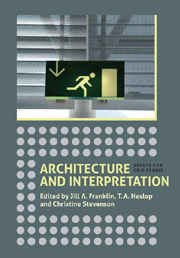Book contents
- Frontmatter
- Contents
- List of Illustrations
- Preface: In Appreciation
- List of contributors
- 1 Introduction
- Incitements to Interpret in Late Antique and Medieval Architecture
- Authors and Intentions
- Architecture beyond Building
- 266 Innovation and Traditionalism in Writings on English Romanesque
- 284 Why Medieval Ireland Failed to Edify
- 306 The Chapel of the Hospital of Saint-Jean at Angers: Acta, Statutes, Architecture and Interpretation
- 315 Sealed Architecture: City Seals, Architecture and Urban Identity in the Northern Netherlands, 1200–1700
- 333 Style and Geography: Struggles for Identification in the Later Nineteenth Century
- 343 The Dome of the Rock: From Medieval Symbol to Modern Propaganda
- 357 Towards a Cultural Geography of Modern Memorials
- 381 Bicycle Sheds Revisited, Or: Why are Houses Interesting?
- Index
306 - The Chapel of the Hospital of Saint-Jean at Angers: Acta, Statutes, Architecture and Interpretation
from Architecture beyond Building
Published online by Cambridge University Press: 05 April 2013
- Frontmatter
- Contents
- List of Illustrations
- Preface: In Appreciation
- List of contributors
- 1 Introduction
- Incitements to Interpret in Late Antique and Medieval Architecture
- Authors and Intentions
- Architecture beyond Building
- 266 Innovation and Traditionalism in Writings on English Romanesque
- 284 Why Medieval Ireland Failed to Edify
- 306 The Chapel of the Hospital of Saint-Jean at Angers: Acta, Statutes, Architecture and Interpretation
- 315 Sealed Architecture: City Seals, Architecture and Urban Identity in the Northern Netherlands, 1200–1700
- 333 Style and Geography: Struggles for Identification in the Later Nineteenth Century
- 343 The Dome of the Rock: From Medieval Symbol to Modern Propaganda
- 357 Towards a Cultural Geography of Modern Memorials
- 381 Bicycle Sheds Revisited, Or: Why are Houses Interesting?
- Index
Summary
THE HOSPITAL of Saint-Jean at Angers is remarkable for being one of the most extensive extant complexes of its kind from twelfth- and thirteenth-century Europe (fig. 1). Like most early hospital foundations, it lies on the margins of the city, in this case on the north bank of the Maine, across the river from Angers itself. It is not only exceptionally complete, but also unusually well documented. The cartulary, published by Célestin Port in 1870, illuminates the lives, deaths and anxieties of many of the hospital's patrons and inmates. Some twenty years after its foundation, it was provided with a detailed set of statutes, among the earliest pertaining to a hospital to reflect the concerns of the reformists in the Church around 1200, concerns which would issue in the provisions of the Fourth Lateran Council of 1215. Nevertheless, between text and architecture lies, as ever, space for interpretation.
The hospital was founded around 1180 by Stephen de Marçay, seneschal of Anjou for Henry II. Stephen and his brother Reginald were important patrons in Anjou, founding the Grandmontine house at Angers, for instance. It is clear that Stephen was the founder of the hospital; a papal bull of 1181 explicitly states that this is the case, and insists further that Stephen and his descendents should govern – have regimen of – the house. Henry II seems to have been jealous of the social prominence that this brought Stephen de Marçay and his family and, when Henry issued two charters confirming the foundation in 1181, he tried to claim that he had founded and built the hospital himself.
- Type
- Chapter
- Information
- Architecture and InterpretationEssays for Eric Fernie, pp. 306 - 314Publisher: Boydell & BrewerPrint publication year: 2012



